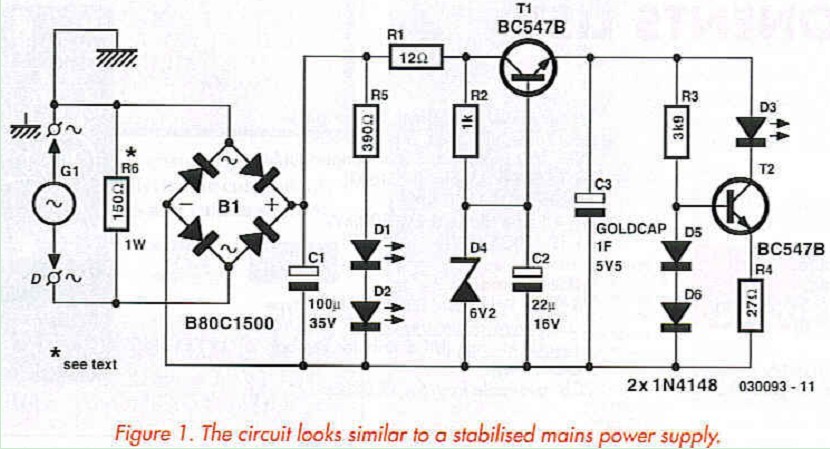

Project Solutions
Bike Tail Light With Standlight (1)
Published:2011/8/2 22:15:00 Author:Phyllis From:SeekIC
By ralf Nolde
Be seen even at standstill!
As autumn approaches cyclists become more aware of safety and in particular their visibility to other road users. Dynamo lighting offers the cheapest running costs but has the disadvantage that when the wheels stop rolling the lights go out. This neat circuit stores energy while you are moving to keep the light shining even when you stop.
It is not too difficult to construct a simple and reliable rear light unit for a cycle dynamo using high visibility LEDs. They have a much longer lifespan than filament lamps and this design uses a high value capacitor to store enough energy to keep the lamp burning for a few minutes after the cycle has come to a standstill.
The circuit
The circuit diagram for the rear light is shown in Figure 1. A typical cycle dynamo will only have a single output terminal; the return path is made through the dynamo body and cycle frame. A connection to the frame will form the earth input while the dynamo output is wired to the D input on the circuit. Rectifier Bl produces a full-wave rectified DC voltage and capacitor CI provides some smoothing. 
The Goldcap capacitor C3 is charged from the rectified dynamo output through resistor Rl and transistor Tl. The zener diode D4 fixes the base of Tl at 6.2 V and its base-emitter drop of 0.7 V ensures that the voltage output at the emitter does not exceed the 5.5 V maximum voltage rating of C3. Capacitor C2 smoothes the voltage reference and resistor Rl limits the charging current through the transistor.
The constant voltage produced by Tl is used to charge C3 and also provide energy to light LED D3 when the bike is moving. D3 is an 8 mm diameter ultra bright red LED with a clear lens and a supply current of 26 mA. The ’F’ suffix indicates that this model has a high luminous intensity in this range of LEDs manufactured by Kingbright (available from Maplin). The LED is driven by a constant current source formed by T2 and this ensures that its brightness is largely independent of the voltage stored on C3. Diodes D5 and D6 fix the base of T2 at approximately 1.4 V which in turn defines the voltage drop across R4 at 0.7 V because it is equal to 1.4 V minus the base-emitter conduction voltage of T2 (VBE = 0.7 V). With the voltage across R4 fixed a quick application of Ohms law indicates that the current through R4 (and therefore D3) is constant at around 26 mA.
With the bike at standstill LED D3 is powered from energy stored in C3. Using the components specified D3 remains lit for at least two minutes before any decrease in brightness is noticeable. This afterglow period is defined by resistor R4, increasing its value to 33 fi or 39 Q will prolong the afterglow at the expense of reduced LED brightness. The light intensity of D3 is much higher than a conventional filament lamp but has a smaller beam angle. The two ’driving’ LEDs Dl and D2 are powered directly from the dynamo output and are positioned either side of D3 to increase the effective beam angle of the rear light assembly when the cycle is moving.
Current consumption of the circuit is approximately 45 mA and with a dynamo output voltage of 6 V this gives a total power consumption of around 0.3 W. This figure is about one half of the power consumed by a conventional filament type rear lamp and reduces loading on the dynamo. The effect of this is that the voltage to the front lamp will be slightly increased and it will burn brighter for a given speed. This will reduce the front lamp lifespan if you habitually descend long hills at high speed. Resistor R6 is fitted as a ’dummy load’ to avoid this potential problem but if you never break into a sweat while pedalling and your cycle is the type fitted with wicker baskets, you are unlikely to need this precaution and R6 may be omitted.
Reprinted Url Of This Article: http://www.seekic.com/blog/project_solutions/2011/08/02/Bike_Tail_Light_With_Standlight_(1).html
Print this Page | Comments | Reading(3232)
Article Categories
New published articles
· Imagination works with TSMC to develop FinFET process
Author:Ecco Reading(33516)
· XMOS pushes event-driven MCUs with lower price
Author:Ecco Reading(3534)
· Intel brings upgraded 32-nm SoC for smartphones
Author:Ecco Reading(3250)
· Micron pushes TLC 128-Gbit NAND flash
Author:Ecco Reading(3816)
· Intel will stop supplying desktop motherboards
Author:Ecco Reading(5341)
· Processor market was expected to regain strength in 2013
Author:Ecco Reading(3318)
· It was reported that TSMC sales fall steeply
Author:Ecco Reading(3474)
· Cisco, NXP work with auto wireless startup
Author:Ecco Reading(3620)
· Micron was impacted by manufacturing glitch
Author:Ecco Reading(4017)
· China can make 22-nm transistor by themselves
Author:Ecco Reading(3819)
· Chip market rebound is coming, according to survey
Author:Ecco Reading(3760)
· Sony, Toshiba will spend more on chips, iSuppli reports
Author:Ecco Reading(3790)
· Qualcomm becomes the 13th company to join NFC Forum board
Author:Ecco Reading(6103)
· TSMC increases building work for FinFET fab
Author:Ecco Reading(3778)
· TI plans to cut 1,700 jobs in OMAP shift
Author:Ecco Reading(4587)